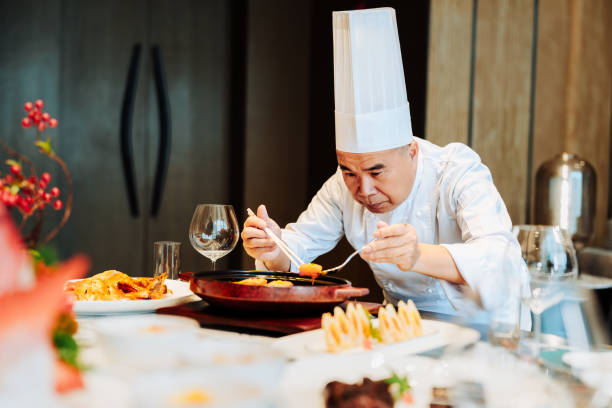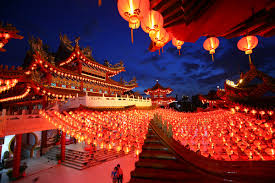A Culinary Epic Rooted in Antiquity
Chinese cuisine is far more than a collection of dishes; it is a profound cultural expression, a living art form deeply rooted in ancient philosophy, rich traditions, and diverse regional identities. From the intricate balance of flavors to the symbolic meanings embedded in each meal, Chinese food offers a captivating journey into the heart of a civilization that has long recognized the intimate connection between food, health, and well-being. This article explores the philosophical foundations, communal rituals, and regional diversity that together define the enduring spirit of Chinese cuisine.
The Philosophical Core: Yin-Yang and the Five Elements At the heart of Chinese culinary philosophy lies a sophisticated understanding of balance, derived from the principles of Yin-Yang and the Five Elements (Wu Xing). These ancient insights dictate not only how food should be prepared but also how it interacts with the human body and the natural world.
Yin and Yang in Cuisine The Yin-Yang concept emphasizes harmony through opposing forces. Foods are categorized as “Yin” (cooling, moistening, expanding—e.g., cucumber, watermelon, green beans, cabbage) or “Yang” (warming, drying, contracting—e.g., garlic, onion, leek, ginger, chili, cinnamon). The goal in Chinese cooking is to balance these properties to achieve internal equilibrium, adapting dishes to seasons and individual needs. For instance, warming foods are preferred in winter, while cooling foods are favored in summer.
This classification of foods and the emphasis on balance suggest a proactive, preventative approach to health through diet. It extends beyond taste to address the physiological effects of food. Chinese cuisine inherently embraces the concept of “food as medicine,” where dietary choices are integral to maintaining health and preventing illness, rather than merely treating symptoms. This ingrained belief makes Chinese cooking intuitive and adaptable, responding to environmental factors (seasons) and individual health, thus forming a dynamic and personalized culinary tradition.
The Five Elements and the Five Flavors The Five Elements—Wood, Fire, Earth, Metal, and Water—correspond closely with five basic flavors: sour (Wood), bitter (Fire), sweet (Earth), pungent/spicy (Metal), and salty (Water). Each element is also linked to specific organs in the body (e.g., Water to kidneys/bladder, Fire to heart/small intestine). The traditional Chinese Five-Spice Powder was formulated to embody these five tastes, ensuring harmonious culinary strength and promoting internal balance.
The explicit connection between flavors, elements, and organs transcends mere taste matching. It implies that a balanced meal, incorporating all five flavors, contributes to the harmonious functioning of the entire body, mirroring cosmic balance. The formulation of blends like Five-Spice Powder is a direct application of this philosophy. This ancient cosmological framework guided the evolution of culinary practices, making food a tool for holistic well-being. This philosophical depth elevates Chinese cuisine from mere craft to a complex system of knowledge, where every ingredient and cooking method bears deeper significance for health and cosmic harmony.
Food as Medicine (Traditional Chinese Medicine) Traditional Chinese Medicine (TCM) regards nutrition as a potent form of medicine. Many spices and herbs used in cooking, such as ginger (for colds) or salty seaweed (for thyroid nodules), have therapeutic properties. This ancient practice of blending functional benefits with flavor has been documented for over 2,000 years, with texts like the Shennong Bencao Jing.
Food as Social Fabric: Traditions, Festivals, and Rituals In Chinese culture, food is a powerful medium for social bonding, expressing respect, and preserving tradition. Meals are often central to family life, celebrations, and even formal ceremonies, carrying deep symbolic meanings.
The Family Reunion Dinner The Family Reunion Dinner, especially during Chinese Lunar New Year, is a cornerstone of tradition. Dishes are chosen for their symbolic meanings: dumplings (wealth and prosperity), fish (abundance, due to phonetic similarity with “surplus”), and spring rolls (wealth). These meals are vital for family bonding and honoring ancestors.
The deliberate choice of symbolic dishes and focus on family reunion indicate that food is a primary medium for expressing cultural values like filial piety, unity, and aspirations for the future. It’s not just about eating but about connection. These ingrained cultural values drive specific culinary practices and rituals, reinforcing social structures and intergenerational bonds. The act of sharing food becomes a ritual of social cohesion. For visitors, understanding these symbolic meanings enriches their appreciation of Chinese hospitality and cultural nuances, realizing that a meal is often a performance of cultural identity and social relationships.
Festival Foods The Chinese calendar is replete with festivals, each associated with unique culinary traditions. Mooncakes are exchanged and shared during the Mid-Autumn Festival, symbolizing unity and completeness. Zongzi (sticky rice dumplings) are eaten during the Dragon Boat Festival.
Ritual Uses Food and drink have played a prominent role in Chinese religious and ceremonial life for millennia. From ancient ancestor sacrifices during the Shang Dynasty (circa 1250 BCE), involving animals and grains, to modern offerings of fruit and steamed cakes, food is presented to honor spirits and deities. These offerings are meant to ensure good harvests, health, male heirs, business success, and general prosperity. Food also appears in mourning practices, with specific diets and fasting periods reflecting grief.
Historical evidence of food offerings from the Shang Dynasty continuing into modern times, albeit with some changes (e.g., fruit instead of whole animals), reveals remarkable continuity in cultural and religious practices. This shows that ancient beliefs about the spiritual efficacy of food offerings still shape contemporary ritual behaviors, even in a rapidly modernizing society. The enduring power of tradition across time is the causal link. This highlights the deep spiritual and historical layers embedded in Chinese food culture, where every meal can carry echoes of ancient rituals and beliefs.
Communal Dining and Table Etiquette Chinese dining is inherently communal, with dishes placed at the center of a round table (symbolizing unity) for all to share. Table etiquette is paramount, including using communal chopsticks for serving, serving elders first, and offering the best portions to others. Hosts typically order a variety of dishes (meat, vegetables, hot, cold) and ensure there is more than enough food, a sign of hospitality.
The focus on round tables, shared dishes, and specific serving protocols contrasts sharply with individualistic Western dining. This is not merely a preference; it is a structured interaction. The collectivist nature of Chinese society manifests directly in dining practices, reinforcing social hierarchy, mutual respect, and group cohesion. The meal becomes a performance of social harmony. For foreign visitors, understanding and adhering to these etiquettes is crucial for successful social and business interactions, signaling respect for cultural norms.
Culinary Tapestry: The Eight Great Cuisines of China Speaking of “Chinese food” as a single entity overlooks a vast, vibrant culinary landscape. China’s immense size, geographical diversity, and varied climates have given rise to eight distinct culinary traditions, each with unique characteristics, flavors, and ingredients.
| Cuisine Name (Chinese/Pinyin) | Region | Key Characteristics/Flavors | Famous Dish Example |
|---|---|---|---|
| Cantonese (粤菜 Yuècài) | Guangdong, Hong Kong | Sweet, light, umami, favors soups and seafood | Dim Sum, Char Siu, Steamed Fish with Ginger and Scallions |
| Sichuan (川菜 Chuāncài) | Sichuan, Chongqing | Spicy, numbing (mala), bold, aromatic, pungent | Mapo Tofu, Kung Pao Chicken, Sichuan Hotpot |
| Jiangsu (苏菜 Sūcài) | Jiangsu, Shanghai | Fresh, mildly salty and sweet, elegant, artistic presentation | Lion’s Head Meatballs, Beggar’s Chicken, Yangzhou Fried Rice |
| Zhejiang (浙菜 Zhècài) | Zhejiang | Fresh, light, slightly sweet, seafood-focused | West Lake Vinegar Fish, Dongpo Pork, Longjing Shrimp |
| Fujian/Min (闽菜 Mǜcài) | Fujian | Light, mild sweet and sour, umami, aromatic, uses sea and mountain ingredients | Buddha Jumps Over the Wall, Oyster Omelette, Red Yeast Chicken |
| Hunan (湘菜 Xiāngcài) | Hunan | Very spicy, sour, rich, favors stir-frying, steaming, smoking | Chairman Mao’s Red Braised Pork, Steamed Fish Head with Chopped Chilies, Spicy Cumin Ribs |
| Anhui (徽菜 Huīcài) | Anhui | Earthy, rich, natural, uses wild herbs and bamboo shoots | Turtle Soup, Stinky Mandarin Fish, Bamboo Shoots with Pork |
| Shandong (鲁菜 Lǔcài) | Shandong | Salty, crispy, favors slow cooking and seafood, uses vinegar and salt | Peking Duck, Braised Sea Cucumber, Sweet and Sour Carp |
The detailed descriptions of the Eight Great Cuisines clearly demonstrate vast differences in ingredients, flavors, and cooking techniques across regions. This is not merely diversity; it is fundamental variation. China’s immense geographical and climatic diversity, along with historical and cultural developments, directly led to the evolution of these distinct culinary traditions. This challenges the monolithic perception of “Chinese food.” For travelers, it means that an authentic culinary experience in China requires regional exploration, as food in Beijing will differ markedly from that in Chengdu or Guangzhou.
Conclusion: The Enduring Spirit The spirit of Chinese cuisine is a magnificent tapestry woven from philosophical threads, ancient traditions, and vibrant regional diversity. It is a cuisine that nourishes not just the body but the spirit, fosters connections, honors history, and celebrates the intricate balance of life. Understanding these deep layers enriches every bite, transforming a meal into a profound cultural and philosophical experience.








